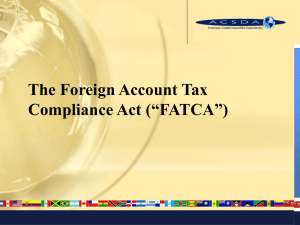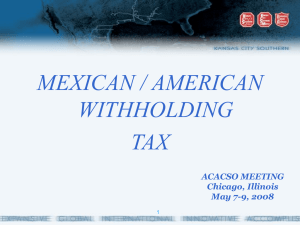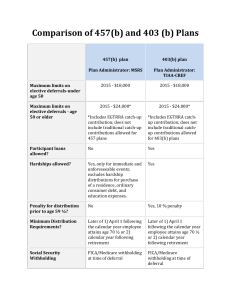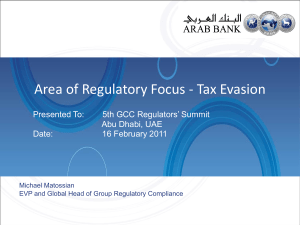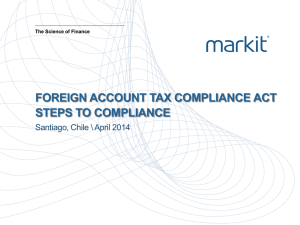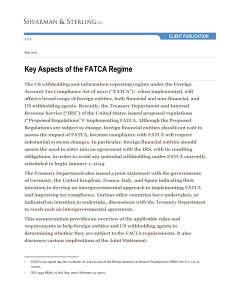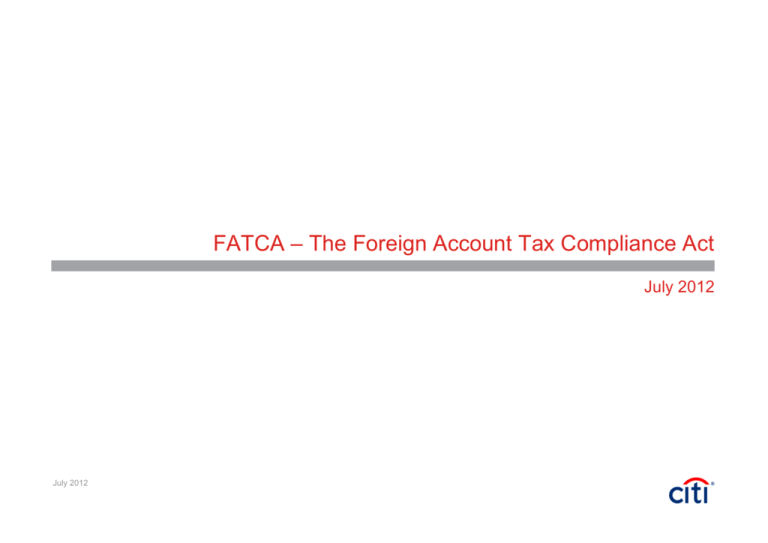
FATCA – The Foreign Account Tax Compliance Act
July 2012
July 2012
Table of Contents
1. Classification
2
2. Due Diligence
7
3 Withholding Payments
3.
14
4. Reporting
21
What You Need to Take Away From This Session
Increase your understanding of FATCA regulation and policy changes.
The principles of FATCA
– The four pillars of FATCA
Classification
Due Diligence
Withholding
Reporting
– Who
Wh is
i iimpacted?
t d?
1
1. Classification
Objective of FATCA
FATCA’s objective is to uncover US tax evaders who invest directly in off-shore accounts or indirectly through
ownership of foreign entities
To reach this goal, FATCA will require foreign financial institutions (FFIs) to provide information to the IRS on US
accounts. In addition, passive non-financial foreign entities (NFFEs) will be required to provide information on
substantial US owners to withholding agents
To enforce compliance, a 30% withholding tax will be imposed on certain payments made to FFIs and NFFEs
th t fail
that
f il to
t make
k the
th required
i d disclosures
di l
FFIs
USFIs
D Dili
Due
Diligence
2
Classification
Withh ldi
Withholding
R
Reporting
ti
Foreign Financial Institutions (FFIs)
An FFI is any non-US entity (i.e. created or organised outside the US) that falls into one of the following categories
– Accepts deposits in the ordinary course of a banking or similar business (e.g. a bank)
– Holds, as a substantial part of its business, financial assets for the account of others (e.g. a custodian)
– IIs engaged,
d or holds
h ld it
itself
lf outt as b
being
i engaged,
d iin th
the b
business
i
off iinvesting,
ti
reinvesting,
i
ti
or ttrading
di iin fifinancial
i l
instruments, including derivative contracts (e.g. mutual funds, hedge funds, private equity funds)
– An insurance company that issues annuities or cash value insurance policies
– Observation: This definition is very
y broad and covers types
yp entities that are not traditionally
y considered
financial institutions
An FFI will suffer a 30% withholding tax on certain types of payments, unless it enters into an agreement with the
IRS to perform certain due diligence, withholding and reporting obligations
– Participating FFI – An FFI choosing to enter into an FFI agreement with IRS and exempt from
FATCA withholding
– Non-participating FFI – An FFI choosing not to enter into an FFI agreement with IRS and subject to
FATCA withholding
– Observation: The Qualified Intermediary (QI) agreement will be amended to require a QI to agree to become a
PFFI and meet the obligations set forth in the FFI agreement
3
Classification
Types of Compliant FFIs
“Participating” FFI – Enters into an FFI Agreement with IRS
– Registration period starts 1 January 2013
– FFI Agreements first become effective 1 July 2013
“Deemed compliant” Registered FFI
– Must register with IRS along with the rest of the expanded affiliated group of FFIs
“Local” FFI
Non-reporting member
Qualified collective investment vehicle
Restricted fund
Deemed Compliant Certified FFI
– May self-certify their status on a Form W-8 without registering with the IRS
Non-registering local bank
Retirement fund
Non-profit organisation
FFI with only low-value accounts
Owner-documented FFI – Withholding agent does the reporting
Excepted FFI (e.g. Foreign governments) – Not subject to withholding
4
Classification
FFI Agreements
FFI Agreements are effective on or after 1 July 2013
PFFI must adopt written policies and procedures regarding due diligence processes
PFFI must conduct periodic internal reviews of its compliance with these policies and procedures and its
FATCA obligations
Observation: US tax authorities will not require mandatory external audits of PFFIs
Within 1 Year of FFI Agreement
Within 2 Years of FFI Agreement
Complete review of all high-value accounts, including
the relationship manager query
Complete review of individual accounts not
previously identified as US accounts and obtain
necessary documentation
Perform the requisite review and obtain documentation Complete review of pre-existing entity accounts not
previously identified as a prima facie FFIs
for all prima facie FFIs
– Form W-8IMY on file indicates FE is a QI or NQI
Complete a responsible officer certification stating
– Review of all high-value individual accounts
is complete
– There were no formal or informal procedures in
place from 6 August 2011, on to assist account
holders in avoidance of Chapter 4 provisions
5
Classification
Complete a responsible officer certification stating
– PFFI has completed the account identification
procedures and documentation requirements for
all financial accounts that are pre-existing
obligations, or if not, that it treats the accounts in
accordance with the requirements as outlined in the
FFI Agreement
Withholding Agents
A withholding agent is any person, US or foreign, that has control, receipt or custody of a Withholdable Payment
Withholding agents are required to
i Classify
i.
Cl
if the
th payees b
by collecting
ll ti and
d verifying
if i d
documentation
t ti under
d d
due dili
diligence rules
l prescribed
ib d b
by th
the IRS
ii. Withhold on Withholdable Payments where documentation is missing, invalid or insufficient
iii. File information returns with the IRS
Withholding: 30% FATCA withholding can apply to
– A Non-participating FFI (“NPFFI”)
– An NFFE that fails to identify its “substantial US owners, unless an exception applies;”
Exceptions are provided for NFFE’s deemed to represent a low risk of US tax evasion (e.g. publicly traded
companies or affiliates of publicly traded companies, foreign governments, and active trades or businesses)
– A “Recalcitrant”
“
” account holder off a participating FFI (“PFFI”)
(“
”)
Any person refusing to supply identifying information relevant to their FATCA status; or
Any identified US person that does not waive any local legal restrictions on reporting relevant information to
th IRS
the
– USFIs are not required to treat undocumented individuals as recalcitrant under FATCA because 28% backup
withholding applies instead
6
Classification
2. Due Diligence
FATCA Compliance and Impact
Critical Distinction
USFIs and PFFIs must adopt written policies and procedures regarding due diligence processes for both
pre-existing and new accounts
– For USFIs, new account procedures should be in place by 1/1/2013
– For PFFIs,
PFFIs new account procedures should be in place by 7/1/2013 or later effective date of the
FFI agreement
For off-shore accounts and pre-existing accounts, the rules try to minimise the amount of ‘new’ information and
documentation that will be needed from account holders,, relying
y g instead on information and documentation
previously provided (for e.g. under local AML / KYC rules)
In some cases, financial institutions will need to collect additional information and documentation to make the
necessary FATCA classifications
USFIs and PFFIs must review customer information for indicia, or indicators, of US status and request
documentation from an account holder if one or more indicia of US ownership are found
7
Due Diligence
Account Distinctions
Direct US Accounts
Indirect US Accounts
A direct account maintained by an account holder
that is a “specified” US Person
An account held by a US owned non-financial
foreign entity is a US account
Excepted US persons
– Publicly traded corporations or affiliates
– Tax-exempt organisations and IRAs
– Federal, state or local government or
an instrumentality
– Banks, dealers in securities, commodities
or derivatives
– Real Estate Investment Trusts (REITs)
– Regulated Investment Companies (RICs)
– Common trust funds and charitable trusts
8
Due Diligence
– Whether held at an FFI or a USFI
A US owned NFFE is a passive foreign entity that
has one or more substantial US owners
“Substantial” ownership means
– More than 10% of a corporation’s stock, a profit or
capital interest in a partnership or a beneficial
interest in a foreign trust
– Any portion of a foreign trust that is classified as a
grantor trust and is taxable to a US grantor
In contrast,
contrast most know your customer (“KYC”)
( KYC )
regimes require identification of owners of a
minimum of a 25% interest in privately held entities
Account Distinctions (Cont’d)
Off-shore vs. On-shore Obligations
Individual vs. Entity Account
Off-shore Obligation
Entity – Anyone other than a natural person.
Includes corporations, partnerships, trusts, estates
– Any account, instrument, or contract maintained
and executed at an office or branch of the
withholding agent at any location outside of
the US
– For any
yp
payment
y
made or sale effected outside of
the US with respect to an off-shore obligation
– USFIs and FFIs can rely on documentary
evidence or written statements to establish
foreign status
– If there are any US indicia, additional
documentation must be obtained to substantiate
foreign status
– Form W-9 must be used to establish US status
On-shore obligations
– Forms W-8 must be collected to establish
foreign status
– If there are any US indicia, additional
documentation must be collected to substantiate
claims of foreign
g status
9
Due Diligence
Financial Institutions
– USFIs
– FFIs – Participating, Non-Participating, Deemed
Compliant, Excepted, Owner Documented,
Territory Organised
Non-Financial Entities
– Non-financial US entity
– Non-financial foreign entity (NFFE) – Active,
Passive, Excepted, Territory Organised
Individuals
– US Person
Foreign Person
Recalcitrant
Account Distinctions (Cont’d)
Pre-existing Obligations
Pre-existing Obligations
USFIs – Pre-existing obligations are accounts
opened or contracts entered into prior to
January 2013
Transition rule for 2014 – same as for USFIs
– USFIs must determine the FATCA status of all
pre-existing entity accounts
However, no due diligence is prescribed for
accounts held by individuals at a USFI
– Transition rule for 2014 – A withholding agent
must withhold on withholdable payments made to
pre-existing
p
g accounts in 2014 only
y if the p
payee
y is
A Prima Facie FFI
But is not a PFFI, a DCFFI or an exempt
beneficial owner
– USFIs must complete due diligence on other
entity accounts by 1/1/2015
PFFIs – pre-existing obligations are accounts
opened or contracts entered into prior to FFI
Agreement effective date (no earlier than 7/1/2013)
– For individual accounts, a PFFI must
document any pre-existing account that has
certain
t i US iindicia
di i
10
Due Diligence
Unless a PFFI elects otherwise, it is not required to
document a pre-existing account if
– No account holder has previously been
documented as a specified US Person, and
– The aggregate balance or value of the account
and any related accounts is US$50,000 or less for
individuals or US$250,000 or less for entities
New Obligations
g
Obligation will include any account, instrument,
or contract maintained or executed by the
withholding agent
USFIs – accounts opened 1 January 2013 or later
FFIs – accounts opened prior to FFI Agreement
effective date, which will be no earlier than
1 July 2013
Both USFIs and FFIs must obtain sufficient
documentation to identify and classify the payee/
account holder
Pre-existing Off-shore Accounts at PFFIs
Individual accounts >US$1 million (as aggregated) subject to “enhanced review,” which must be completed within
one year
– Enhanced due diligence means review of all AML / KYC documentation for the account and related accounts
and includes an inquiry
q y of a relationship
p manager
g
All other individual accounts subject to an electronic search for indicia of US status within two years
– If indicia found, account must be documented essentially as if it were a new account
– If no indicia
i di i ffound,
d can ttreatt the
th accountt as “not
“ t a US account”
t”
– Pre-existing individual accounts are retested at the end of each subsequent year for >US$1 million status; if so,
enhanced review required
Pre-existing entity accounts that are not classified as prima facie FFIs must be documented essentially as if they
were new accounts within two years
11
Due Diligence
Summary of Due Diligence for Pre-existing Accounts at a PFFI
Pre-existing Account Remediation
Account
T
Type
Exempted
Completed Within Two years of FFI
R i t ti
Registration
Completed Within One year of FFI
R i t ti
Registration
Individuals
US$50,000 or Less
US$50,000–1,000,000
High Value >US$1,000,000
Exempted
Electronic Search for US Indicia
Electronic Search for US Indicia
Manual Search as Required
Relationship Manager Query
Entities
12
Due Diligence
US$250,000
$
,
or Less
> US$250,000
$
,
Prima Facie FFIs
Exempted
Review AML / KYC documentation
Review AML / KYC documentation
Document FATCA Status
Document FATCA Status
US Indicia of Individual Accounts at a PFFI
PFFIs must review customer information for indicia, or indicators, of US status and request documentation from an
account holder if one or more indicia of US status are found
An individual account holder is treated as having US indicia if the account includes any of the following
– Identification of account holder as US citizen or resident
– US place of birth (new for 2013)
– US resident or mailing address
– US telephone number (new for 2013)
– Standing instructions to transfer funds to a US based account
– Power of attorney or signatory authority granted to person with US address; or
– In care
care-of
of or hold mail address that is sole address of account holder
13
Due Diligence
3. Withholding Payments
FATCA Compliance and Impact
What is a Withholdable Payment?
On or After 1 January 2014
US source FDAP income (interest,
dividends, royalties, etc.)
On or After 1 January 2015
ADD gross proceeds (plus accrued
interest) from sale / redemption of
securities that produce, or could
produce, US source interest or
dividends
On or After 1 January 2017 at Earliest
Foreign passthru payments paid
by PFFIs
– Not defined in proposed regulations
Examples: Stock or debt issued by a
US corporation or the US government
Interest paid on a deposit at a US
branch of any bank or a non-US branch
of a
US bank
Includes interest paid by Citibank NA at
its non-US branches
Dividend equivalent payments
– Substitute dividends paid under a
securities loan or repo of a US
equity
– Payments
P
t under
d a swap pegged
d tto
dividends on a US equity
14
FATCA Compliance and Impact
Continue withholding on US source
FDAP income, interest on deposits held
at a US branch of anyy bank or a nonUS branch of a US bank, and dividend
equivalent payments
Continue withholding on US source
FDAP income, interest on deposits held
at a US branch of anyy bank or a nonUS branch of a US bank, dividend
equivalent payments and gross
proceeds from US securities
Special Rules on FATCA Withholding
Exceptions from FATCA Withholding
– Short-term interest / OID
Debt with an original term of 183 days or less
Excludes
E l d commercial
i l paper, repos, T
T-bills
bill
– Income effectively connected with the conduct of a trade or business in the US (ECI)
– Sales of fractional shares that would be excluded from Form 1099-B reporting (<US$20)
– “Ordinary course of business” payments for non-financial services, goods and use of property
Bank and brokerage fees not excepted
– Pure introducing broker activities, where no payments are made, are not subject to FATCA
Sale Transactions Effected with Multiple Brokers
– Where multiple brokers are involved in effecting a sale
Each broker must determine whether to withhold based on the status of its payee
p y
– In a Delivery vs. Payment (DVP) or Cash on Delivery (COD) transaction, each broker that pays gross proceeds
is a withholding agent
Payee is the clearing organisation or the custodial bank that receives the gross proceeds
Withholding creates the possibility of failed sales that will result in severe market disruption
15
FATCA Compliance and Impact
Grandfathered Obligations
Payments on obligations outstanding on 1 January 2013
An FI will need to track grandfathered obligations and material modifications on its security data base, loans and
contractual obligations
Grandfathered obligations do not include
– An instrument treated as an equity for US tax purposes
– An agreement that lacks a definitive expiration or term (e.g. savings deposits, demand deposits)
– A brokerage, custodial or similar agreement to hold financial assets for others and collect income
– A master agreement that merely sets forth standard terms and not the specific terms of a particular transaction
Examples
p
of affected obligations
g
– Debt obligations issued by US corporations, the US government or its agencies
– A binding agreement to extend credit for a fixed term (e.g. line of credit or revolving credit facility)
– Repos where the collateral seller is a US legal entity
– A derivatives transaction entered into under an ISDA Master agreement and evidenced by a confirmation
16
FATCA Compliance and Impact
Possible Modified Obligations
How to identify material modifications
– Significant amendment of terms of debt obligation
– Large consent payments made to holders of loans or debt securities in exchange for acceptance of new terms
of debt
– Rely on public documents for federal tax treatment of public debt
– Rely on loan modification documents for privately placed obligations
Repo roll-overs
roll overs – Unless is continuation of same debt
Taxable reorganisation – An exchange of old debt obligations for new debt obligation
17
FATCA Compliance and Impact
Who Is Subject to Withholding?
USFIs
PFFIs
No FATCA obligation to withhold on individuals
PFFIs must withhold 30% on payments to
– Non-participating FFIs
– Includes limited branches and affiliates
– This may mean withholding on payments made to
certain Citi subsidiaries
y
of US source FDAP income to documented
Payments
US persons
– Generally no withholding
– 28% backup withholding if
No TIN
Notification of Name / TIN mismatch
Notification by IRS that payee underreported
dividend or interest income
Payments of US source FDAP income to
non-US individuals
– Withholding at 30% under Chapter 3, unless reduced
by treaty
USFIs must withhold on withholdable payments made to
– Non-participating FFIs (including limited branches
p
facie FFIs))
and affiliates,, and prima
– Electing participating FFIs (including
non-withholding Qis)
– Non-compliant NFFEs
18
FATCA Compliance and Impact
Prima facie FFIs (generally QIs and NQIs not
affirmatively documenting PFFI status)
Electing participating FFIs
Non-compliant
N
li t NFFEs
NFFE
Recalcitrant accounts (undocumented individuals)
Withholding Practicalities
FATCA withholding is 30%
FATCA withholding cannot be reduced by either statute or treaty
Generally speaking,
speaking if there is FATCA withholding,
withholding then there would not be any US non-resident withholding
(Chapter 3) or backup withholding (Chapter 61)
– If there is an NQI that is a PFFI and some of the underlying account holders are documented for FATCA
purposes and others are not, those who are not properly documented for FATCA purposes would be withheld at
30% while the other account holders may be subject to a different rate
19
FATCA Compliance and Impact
Withholding Timeline
Types of Payments Subject to Withholding
Fixed, Determinable, Annual or Periodic (FDAP) Income from US sources
Tax Year
First Reporting
Date
2014
2015
2015
2016
After
1 January 2017
TBD
Dividends
Interest
Other US Source Income
Gross proceeds from US securities
Sales or Redemptions of Stock, Mutual Fund Shares, Debt Obligations, or Other
Securities
Capital Gain Distributions
Return of Capital Distributions
Foreign “Passthru”
Passthru Payments
Allocable Amount of US Source Income Distributed to Non-participating FFIs or
Recalcitrant Accounts
20
FATCA Compliance and Impact
4. Reporting
FATCA Compliance and Impact
Information Reporting By USFIs
Payee Type
US Non-exempt
Recipient
Report What
Name, TIN and address of
non-exempt recipient
Form Type
1st Tax Year
IRS Due Date
Authority
1099
2013
March 31
(Electronic Filing)
IRC §§6041, 6042,
6045 and 6049
A
Aggregate
t amountt for
f each
h income
i
type, or
Separate amount for each position
(OID or gross proceeds)
Ownerdocumented FFI
Name of FFI to which a Chapter 4
reportable amount is paid
TBD
2014
TBD
§1.1474-1(i)(1)
TBD
2014?
March 15
§1.1472-1(e)(2)
1042-S
2014
March 15
§1.1474-1(d)
Name, TIN, address of each specified
US person that has a direct or indirect
interest in the FFI
Substantial US
Owners of an
NFFE
Name of NFFE
Foreign Recipient
Name, address, and TIN
Name, TIN, address of each
substantial US owner (unless
excepted)
Aggregate reportable amount for each
income type
US tax withheld, if any
21
Withholding Payments
Reporting by PFFIs on US Accounts
Phased-in reporting on US accounts
For 2013 report US accounts identified as of 6/30/2014
For tax year 2013 and 2014 – Report for each account holder
– Name / address / TIN of each specified US account holder
– Name / address / TIN (if any) of NFFE account holder and name / address / TIN of each substantial US owner
of the NFFE
– Account number
– Account balance / value at year-end or closing date
For 2015 – Report
p same as for p
prior yyears,, p
plus
– Gross US and foreign source income
For 2016 – Report same as for 2015, plus
– Gross proceeds from sale / redemption of property
Due date 31 March
– Except reporting for 2013 due 9/30/2014
22
Withholding Payments
US Payors that are PFFIs
US payors (other than US branches) that are PFFIs (e.g. US controlled foreign corporations)
Must meet the same reporting requirements as PFFIs that are not US payors, but
US payors that report US non-exempt recipients on Form 1099 as required satisfy the Chapter 4 reporting
requirements on such US accounts
US payors with established 1099 reporting systems may wish to elect to report US accounts on Forms 1099 to
satisfyy Chapter
p 4
– Would apply to accounts held by
Specified US persons who are exempt recipients, and
NFFEs who are exempt foreign persons but have substantial US owners
If US payor reports on Form 1099, it must also report the account number and the identity of an account holder
that is an NFFE
23
Withholding Payments
Reporting by PFFIs on Recalcitrant Accounts
PFFI must report separately the aggregate number and total value of recalcitrant accounts in each of the
following categories
– Recalcitrant accounts that have US indicia
– Recalcitrant accounts that lack US indicia
– Recalcitrant accounts that are dormant
Due dates
– For 2013 – due 9/30/2014
– For 2014 and later – due 3/31 of following year
Form type to be determined
24
Withholding Payments
Form 1042-S Recipients
All withholding agents must report on Form 1042-S to the following types of recipients
– PFFI or DCFFI, even if acting as an intermediary
– NPFFI that is a beneficial owner
– A PFFI accountt holder
h ld if the
th PFFI does
d
nott have
h
withholding
ithh ldi responsibility
ibilit
– An NFFI that is not a flow-thru entity
– Partner, owner or beneficiary of a flow-thru entity that is a NFFE when treated as a beneficial owner
– An exempt beneficial owner
– QI that is a foreign branch of a US person
– Limited branch of a PFFI
25
Withholding Payments
Amounts Reportable on Form 1042-S
Reportable amounts by all withholding agents
– US source FDAP income paid after 12/30/2013 whether or not subject to withholding
– Gross proceeds from the sale or redemption of US securities that are subject to withholding after 2014
– Foreign
F i passthru
th payments
t subject
bj t to
t withholding
ithh ldi after
ft 2016
For 2015 and 2016, PFFIs must report foreign source income paid to NPFFIs on Form 1042-S
– IRS may use this information to project the amount of pass-through payments that could be subject to
withholding after 2016
26
Withholding Payments
FATCA Reporting Timeline
Type
Recalcitrant Account Reporting (With US Indicia, Without US Indicia,
and Dormant)
Tax Year
First Reporting
Due Date
2013
30 September
2014
2013 and 2014
2014 and 2015
Income for US Accounts Must Also be Reported
2015
2016
Full Reporting for US Accounts, Including Gross Proceeds from Sales
of securities
2016
2017
US Accounts (Name, Address, Account Number, Account Balance or Value)
May elect to report all amounts paid to US persons as if the PFFI were a US payor, except that information for US
exempt recipients must also be reported
Incremental reporting of substantial US owners of non
non-US
US entities,
entities including the name of the entity and US
owner details
27
Withholding Payments
IRS Circular 230 Disclosure: Citigroup Inc. and its affiliates do not provide tax or legal advice. Any discussion of tax matters in these materials (i) is not intended or written to be used, and cannot be used or relied
upon, by you for the purpose of avoiding any tax penalties and (ii) may have been written in connection with the "promotion or marketing" of any transaction contemplated hereby ("Transaction"). Accordingly, you
should seek advice based on your particular circumstances from an independent tax advisor.
advisor
Any terms set forth herein are intended for discussion purposes only and are subject to the final terms as set forth in separate definitive written agreements. This presentation is not a commitment to lend, syndicate a financing,
underwrite or purchase securities, or commit capital nor does it obligate us to enter into such a commitment, nor are we acting as a fiduciary to you. By accepting this presentation, subject to applicable law or regulation, you agree to
keep confidential the information contained herein and the existence of and proposed terms for any Transaction.
Prior to entering into any Transaction, you should determine, without reliance upon us or our affiliates, the economic risks and merits (and independently determine that you are able to assume these risks) as well as the legal, tax and
accounting characterizations and consequences of any such Transaction. In this regard, by accepting this presentation, you acknowledge that (a) we are not in the business of providing (and you are not relying on us for) legal, tax or
accounting advice, (b) there may be legal, tax or accounting risks associated with any Transaction, (c) you should receive (and rely on) separate and qualified legal, tax and accounting advice and (d) you should apprise senior
g
in yyour organization
g
as to such legal,
g , tax and accounting
g advice ((and any
y risks associated with any
y Transaction)) and our disclaimer as to these matters. By
y acceptance
p
of these materials,, you
y and we herebyy agree
g
that
management
from the commencement of discussions with respect to any Transaction, and notwithstanding any other provision in this presentation, we hereby confirm that no participant in any Transaction shall be limited from disclosing the U.S. tax
treatment or U.S. tax structure of such Transaction.
We are required to obtain, verify and record certain information that identifies each entity that enters into a formal business relationship with us. We will ask for your complete name, street address, and taxpayer ID number. We may
also request corporate formation documents, or other forms of identification, to verify information provided.
Any prices or levels contained herein are preliminary and indicative only and do not represent bids or offers. These indications are provided solely for your information and consideration, are subject to change at any time without notice
and are not intended as a solicitation with respect to the purchase or sale of any instrument. The information contained in this presentation may include results of analyses from a quantitative model which represent potential future
events that may or may not be realized, and is not a complete analysis of every material fact representing any product. Any estimates included herein constitute our judgment as of the date hereof and are subject to change without
any notice. We and/or our affiliates may make a market in these instruments for our customers and for our own account. Accordingly, we may have a position in any such instrument at any time.
Although this material may contain publicly available information about Citi corporate bond research, fixed income strategy or economic and market analysis, Citi policy (i) prohibits employees from offering, directly or indirectly, a
favorable or negative research opinion or offering to change an opinion as consideration or inducement for the receipt of business or for compensation; and (ii) prohibits analysts from being compensated for specific recommendations
or views contained in research reports. So as to reduce the potential for conflicts of interest, as well as to reduce any appearance of conflicts of interest, Citi has enacted policies and procedures designed to limit communications
between its investment banking and research personnel to specifically prescribed circumstances.
© 2012 Citibank, N.A. All rights reserved. Citi and Citi and Arc Design are trademarks and service marks of Citigroup Inc. or its affiliates and are used and registered throughout the world.
Citi believes
b li
th t sustainability
that
t i bilit is
i good
d business
b i
practice.
ti
W workk closely
We
l
l with
ith our clients,
li t peer financial
fi
i l institutions,
i tit ti
NGO and
NGOs
d other
th partners
t
t finance
to
fi
solutions
l ti
t climate
to
li t change,
h
d
develop
l industry
i d t standards,
t d d reduce
d
our own
environmental footprint, and engage with stakeholders to advance shared learning and solutions. Highlights of Citi’s unique role in promoting sustainability include: (a) releasing in 2007 a Climate Change Position Statement, the first US
financial institution to do so; (b) targeting $50 billion over 10 years to address global climate change: includes significant increases in investment and financing of renewable energy, clean technology, and other carbon-emission
reduction activities; (c) committing to an absolute reduction in GHG emissions of all Citi owned and leased properties around the world by 10% by 2011; (d) purchasing more than 234,000 MWh of carbon neutral power for our
operations over the last three years; (e) establishing in 2008 the Carbon Principles; a framework for banks and their U.S. power clients to evaluate and address carbon risks in the financing of electric power projects; (f) producing equity
research related to climate issues that helps to inform investors on risks and opportunities associated with the issue; and (g) engaging with a broad range of stakeholders on the issue of climate change to help advance understanding
and solutions.
Citi works with its clients in greenhouse gas intensive industries to evaluate emerging risks from climate change and, where appropriate, to mitigate those risks.
efficiency, renewable energy & mitigation

